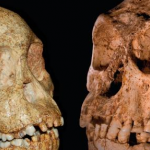Homo floresiensis
The Hobbit is a book by JRR Tolkien, a just released blockbuster movie, and a hominid from Indonesia. Here, we are speaking about the hominid from Indonesia.
A while back I wrote a review of a book by Dean Falk, for American Scientist. You can find that review here, and you can find a different review of the same book here on my blog.
Falk's book is about endocasts and brains her area of specialty and she goes into the study of two specific hominids in particular, Taung, and LB1. Taung (pronunced "Tah oong," roughly) is the type specimen of Australopithecus africanus, the first described…
Excellent one at A Primate of Modern Aspect:
Okay, so we've got lots of increases in brain size, and a few decreases. In the cases where we have decreases, we usually have body size decreases as well. More often than not, we have body size decreases which result in a disproportionately large brain size, but occasionally we have a body size increase which results in a disproportionately small brain size. And all of that brings us to the Hobbit.
The authors looked at Homo floresiensis in relation to the Dmanisi hominids, Homo habilis, and a Homo erectus from Ngangdong and found that if we…
Is the Hobbit's Brain Unfeasibly Small?:
Brain expansion began early in primate evolution and has occurred in all major groups, suggesting a strong selective advantage to increased brainpower in most primate lineages. Despite this overall trend, however, Mundy and his colleagues have identified several branches/lineages within each major group that have shown decreasing brain and body mass as they evolve, for example in marmosets and mouse lemurs.
According to Mundy, "We find that, under reasonable assumptions, the reduction in brain size during the evolution of Homo floresiensis is not…
